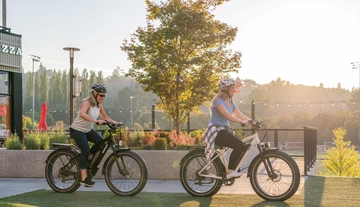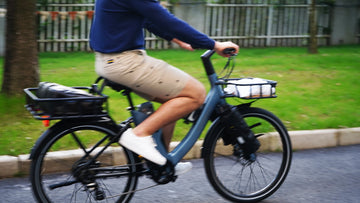Electric bikes are quickly becoming the most preferred bikes due to their features. Before getting an ebike, you should know which class is allowed in your city. Most times, these ebikes are not considered a motorcycle by law. Knowing this would prevent you from being fined by authorities and help keep yourself and others safe.
Hence, the rules and regulations governing electric bikes vary from one state to another. These rules include what gear you can wear, ebike routes, etc. Here in the U.S, ebikes classifications are class 1, class 2, and class 3. Some states make use of a standard system in determining electric bike classification. The motor and speed levels choose to classify the ebikes.
The Himiway brand has various classes of electric bikes for its different types of riders. To understand the three electric bike categories, you need to know the following:
E-Bike Classes: What Are They?
Ebike is incredibly diverse, and each country has different ways of classifying them. These classifications help distinguish between various e-bike kinds and their capacities. Contrary to popular belief, e-bikes are not categorized based on size or frame. Instead, these different e-bike classes are based on their top speed and the existence of throttles or pedal-assist. Depending on the state or region you're riding in, the various classifications of e-bikes have to follow state laws. Therefore, it's crucial always to be aware of local laws before riding.

Class 1 Ebike
Class 1 e-bikes are electric bikes that don't have a throttle however use pedal-assisted with a top speed of up to 20mph. The pedal assist assists when you are pedaling and stops when it reaches 20mph. These Pedal-assist electric bicycles are a good option if you don't want to use a throttle. With a class 1 electric bike, you can change your settings based on your riding needs, whether it's more power to glide you home after a long day or a little boost to overcome traffic.
Class 1 e-bikes are adaptable and are similar to a non-motorized bicycles and how their power is delivered. These categories are least likely to be subjected to regulations due to low speed. Currently, in the United States, some rules govern different classes of e-bikes in about 26 states. These laws often include restrictions on where you can ride your e-bike. Class 1 electric bikes can go on straight, paved roads, single-track mountain trails, and shared-use bike lanes. These laws depend on the state's legal framework; some states, like Michigan, allow Class 1 e-bikes on all roadways and bike lanes. If you usually use your electric bicycle on public streets and highways, a class 1 ebike is the most suitable for you. Moreover, most individuals start off using ebike with this class.

Class 2 Ebikes
Although, this ebike has some similarities with class 1 e-bikes. The class 2 e-bikes have a pedal assist. However, the motor can also move your bike without you pedaling. Once the e-bike gets a speed of more than 20 mph, the electric motor stops supplying power to drive the e-bike. The class 2 electric bike is sometimes called a "low-speed throttle-assisted ebike." This implies that if you pedal, the motor will help you. Thus, most Class 2 ebikes include throttles and electrically assisted pedaling, just like the Himiway fat tire Cruiser Electric Bike. These ebikes provide their users with throttles, allowing the engine to run without pedaling.
Thus, off-highway vehicle trails are among the additional surface terrain types for which the class 2 e-bike is suitable. If you need to become more familiar, most trails are well-known routes for enthusiasts with dirt bikes, golf carts, jeeps, and all-terrain automobiles. This mode is most suitable for those injured or with limited mobility who cannot pedal.
Also, Class 2 e-bikes are ideal for people with limb fractures or recovering from an injury. Since riding a class 2 e-bike feels comparable to a motorbike, this could be problematic for inexperienced e-bike riders. Furthermore, class 2 ebikes are best for experienced riders. Moreover, you don't need a license or insurance to ride a class 2 electric bicycle.
Class 3 Ebikes
Electric bikes classified as class 3 bicycles have a pedal-assisted speed of 28 mph. These bikes are the fastest and the most powerful of the three categories of e-bikes, thus making them the big guns of the e-bike world. They only have pedal assistance and no throttles; their motors can get up to 28 mph before they stop.
The only drawback of class 3 e-bikes is that they are the most restricted ebikes due to their speed. However, the rate of these bikes can potentially cause severe accidents and reduce safety. Therefore, class 3 e-bikes can only be used on highways and other public roads, even though you can ride them without a license. You can only ride class 3 ebikes on regular bike lanes, paved areas, and trails. Due to their Speed, Class 3 e-bikes are often not allowed on specific highways.
The increased speed creates more significant potential for risk, at least in most U.S. states with e-bike laws. If you want an ebike suitable for commuting and adventuring, class 3 ebike models are the best for you. However, you must be careful with local rules if you use bike-only paths. When evaluating this category of e-bikes, speed is an essential consideration since having reliable brakes, sturdy tires, and a stable ride will be necessary for keeping you safe while riding. Considering such concerns, this bike class is ideal for commuters rushing to work and someone who needs to cover a lot of distance in a short amount of time. You can ride class 3 electric bikes on roads and on-road bike lanes.
Class 3 e-bikes, like class 2 e-bikes, are intended for users with more experience. Himiway Zebra all-terrain electric bike is an example of Class 3 fat tire ebike and is suitable for all-terrain.
States' E-Bike Road Regulations

Understanding the local, state, and federal laws that govern the use of e-bikes is crucial. It's vital to be aware of these things to avoid problems caused by using an e-bike in places where it's forbidden or to avoid paying a fine for violating the law while using one. To find out where you're allowed to and aren't allowed to ride an e-bike, we strongly advise contacting the transportation department or local authorities (such as the police or Sheriff's office) for the state in the issue. In addition, laws are rapidly changing, and you still need to verify your local laws for ebikes rules.

Conclusion
Choosing an ebike class depends solely on your preference and riding style. These electric bike classifications are most times based on their motor or speed. While riding your ebike, follow all road rules and wear your helmet. If you want an ebike that allows you to use a pedal assist, you could go with class 1. You might choose between class 2 and class 3 specs if you want an ebike with a replaceable battery. You now have access to additional bikeways in the state and more opportunities to use this adaptable, enjoyable, and eco-friendly mode of transportation. Whatever choice you make, Himiway ebikes got you covered as we have the best categories of bikes for you.





































